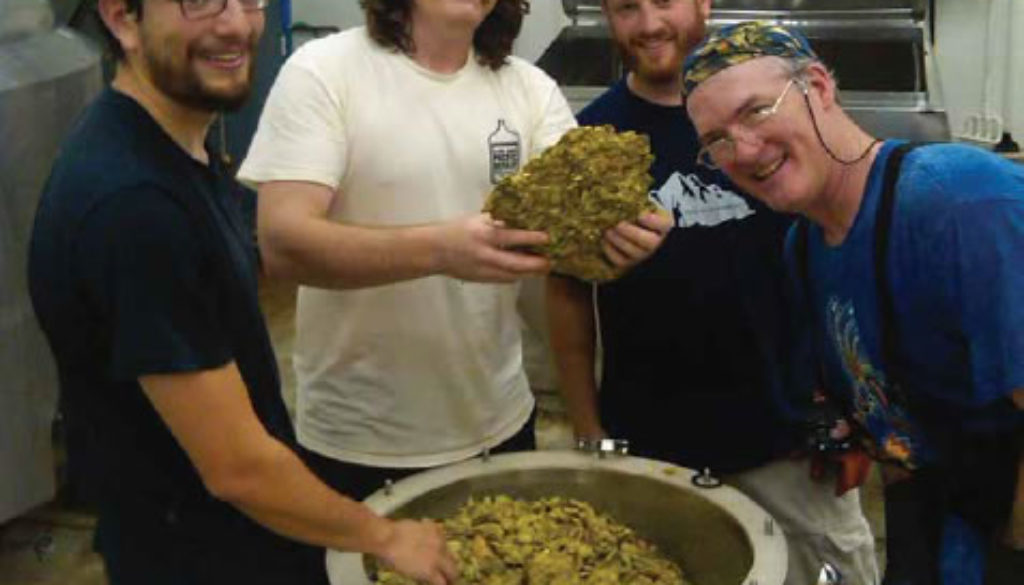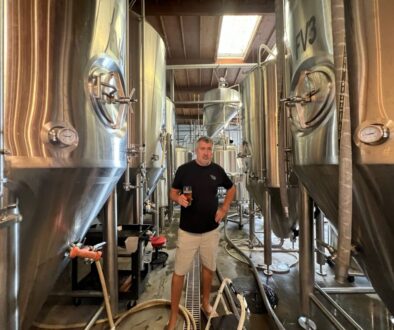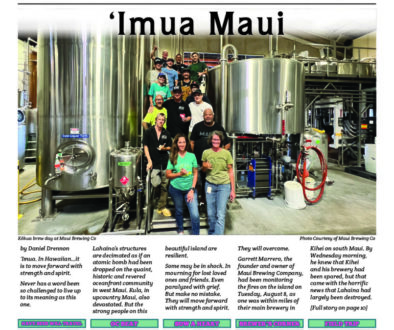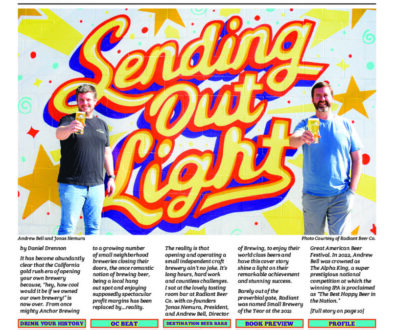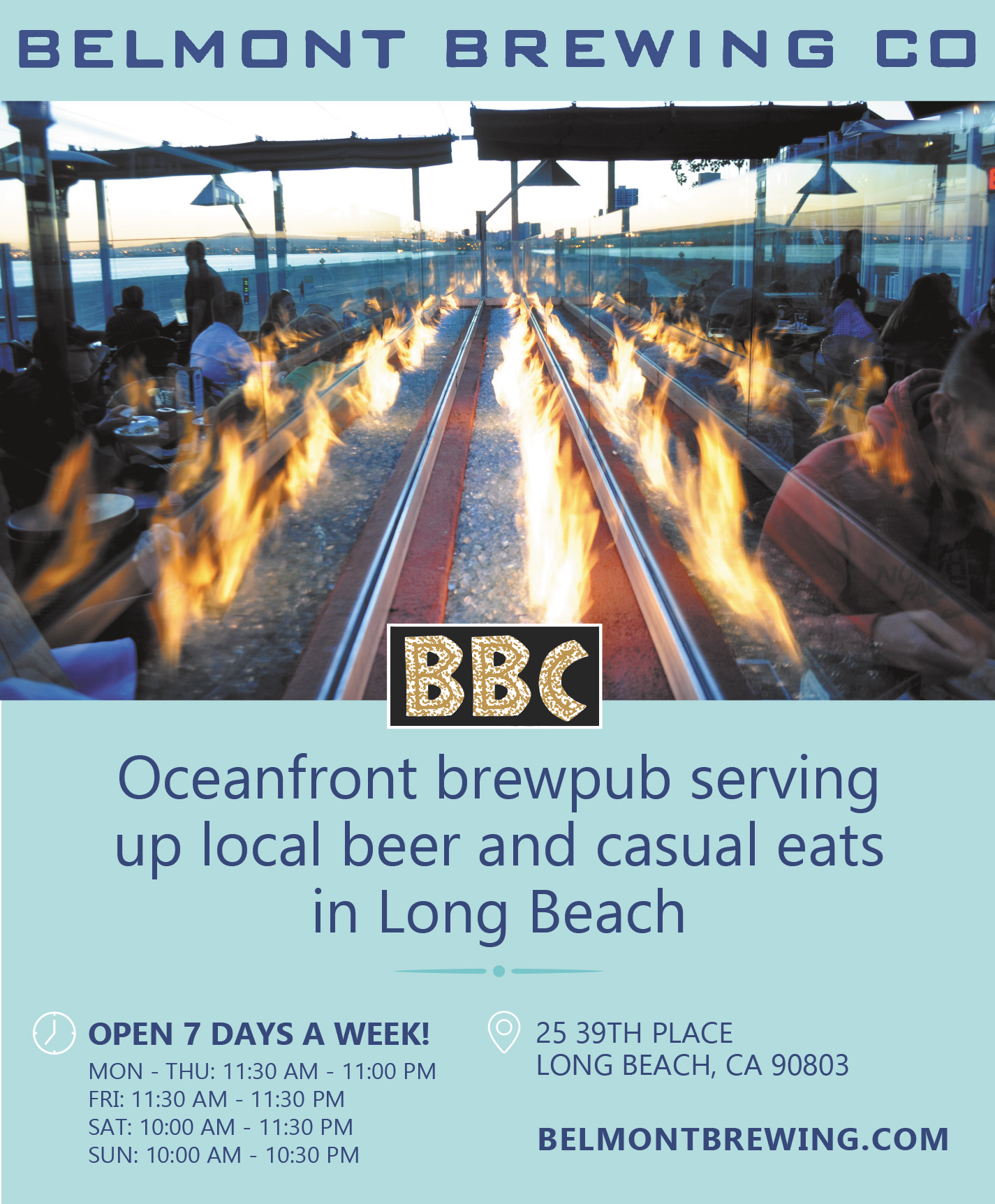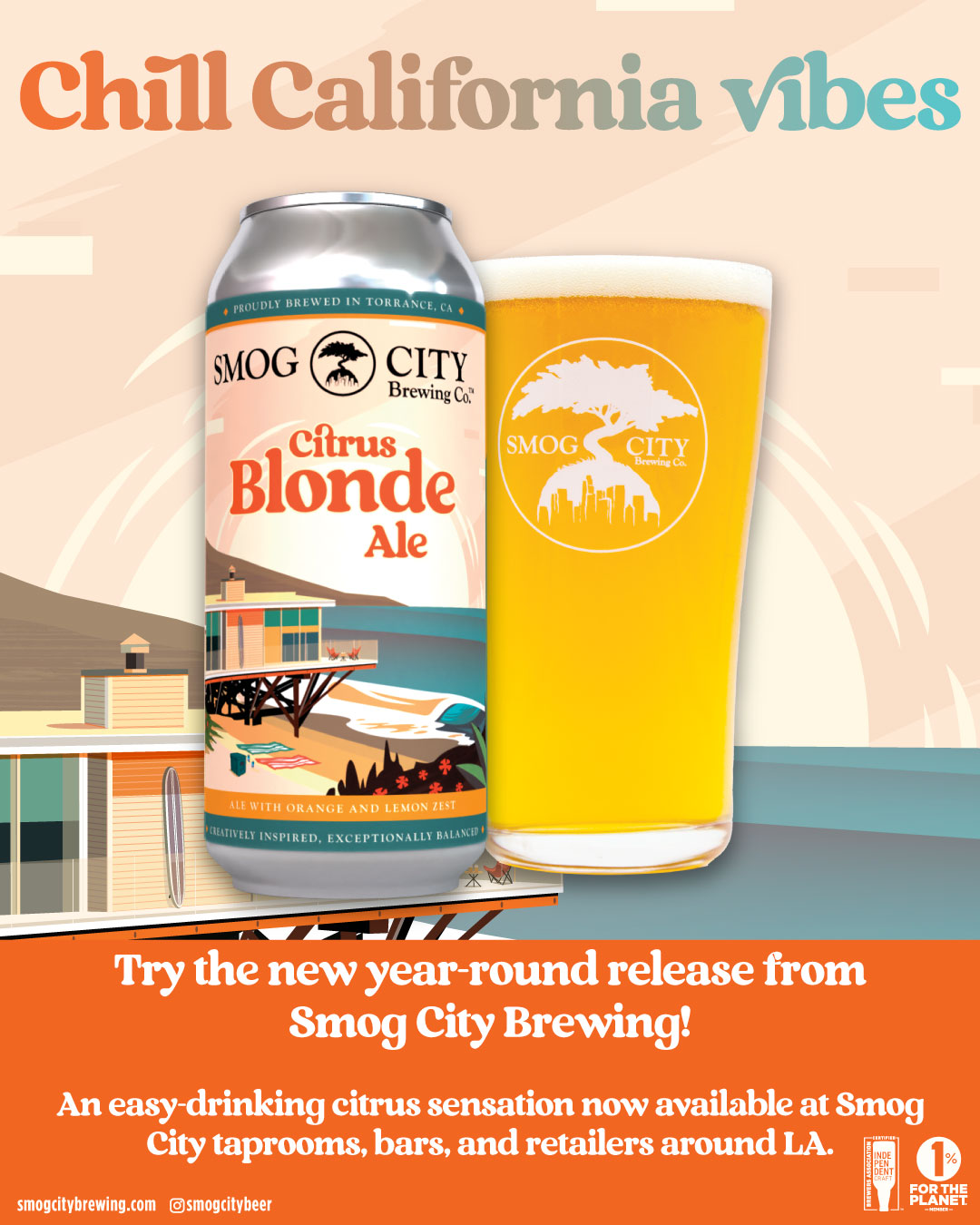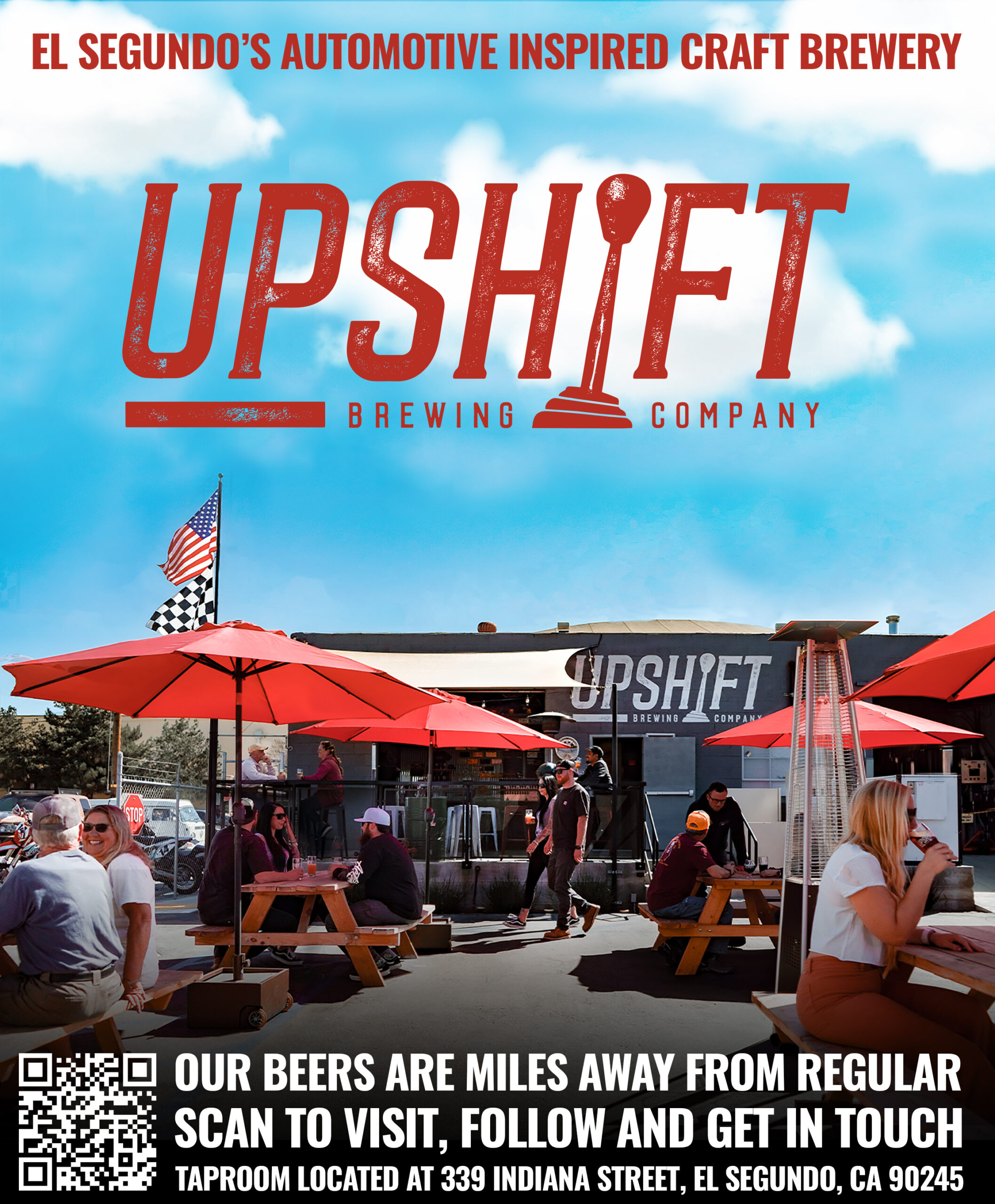Eagle Rock Brewery 10 Years of Beers for the People
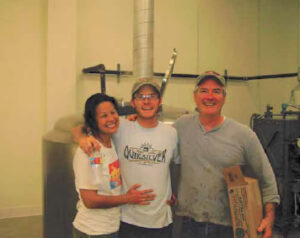
It’s official. The modern craft beer scene in Los Angeles is now 10 years old. And Glassell Park’s Eagle Rock Brewery, co-founded and -owned by husband and wife Jeremy Raub and Ting Su, along with Jeremy’s dad Steve, was at the forefront of that movement when it launched in November 2009 with Solidarity, a 3.8% abv Dark Mild. The beer’s moniker also aptly describes craft community that ERB helped to create and continues to foster.
Although the suitably named Craftsman Brewing, which debuted in Pasadena in 1995 and is still going strong, was our region’s proto-craft harbinger of artisanal ales and lagers to come, it wasn’t until autumn 10 years ago that Eagle Rock, along with two other local breweries — Torrance’s Strand Brewing and Agoura Hills’ Ladyface Ale Companie — began operating, planting the seeds for what is now a 100-brewery scene in LA County.
As ERB is set to celebrate its milestone with an anniversary party later this month, I joined Jeremy and Ting over a couple rounds of Eagle Rock’s AmWolf Pils in their taproom last month and asked them to put on their memory caps to reflect back on the pre-craft days, circa 2006, when I first met them at an Oktoberfest beer tasting at Red Carpet Liquor in Glendale. We also discussed the early days of the brewery, including some high and low points, over the decade.
BEER PAPER: What do you recall of the beer scene in Los Angeles back then?
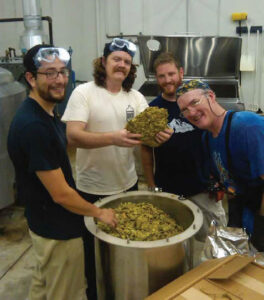
EREMY RAUB: The scene back then definitely felt tight-knit, because there wasn’t much happening.
It was basically a small group of homebrewers and beer fans. Everybody knew each other and we all lamented about the same issues, mainly not having a thriving beer culture in LA. We were all kind of working toward the same goal [filling that void]. We were already deep into our blog about our new startup process to open a brewery.
BP: You were already a member of the Maltose Falcons and you and your dad had been homebrewing, right?
JR: Yeah, we had started back in the early to mid-‘90s where I grew up in western New York. When I moved to LA and started my career in the film industry, my folks moved out not too long after. So it was like, “Hey, you still have that old home brewing equipment; let’s start doing this again — that was a lot of fun.”
BP: When did you decide to take it pro?
TING SU: During the homebrew days, everybody would pipe-dream about having a little brewery someday. Jeremy and his dad talked about how cool it would be. For Jeremy’s 30th birthday, I established the DBA for Eagle Rock Brewery because we knew we wanted to be somewhere
in northeast LA. I gave it to him for his birthday without knowing where it would really take us. But if he was gonna have a pipe dream, then this was probably the only opportunity we were gonna to have where he could put his money where his mouth is, and if the shit hit the fan, we could still just go back to our former careers.
BP: There was no real indication then that we were about to get a beer scene in LA. But everyone was really excited because good beer had already come to Orange County.
JR: Yeah, I remember going down to visit the new breweries. My dad and I went to the Bruery [in Placentia] and talked to Patrick [Rue]. We went to Bootleggers [in Fullerton] and talked to Aaron [Barkenhagen], who at that time still had his day job in the insurance industry. I went down there again with Brian Lethcoe of Nibble Bit Tabby [LA’s second brewery, after Eagle Rock, which unfortunately was short-lived] because he had the same 7bbl brewhouse that Bootleggers had. I wanted to look at their breweries get some ideas and advice on getting started. Both Aaron and Patrick, on separate occasions, told me it would be at least a year to get a brewery started up. But I thought, “No way, man. We’re so organized, we’re gonna just plow right through it…”

TS: Yeah, nearly three years later, we were finally able to open our doors. But those OC breweries were also established in places that were a lot more business-friendly, and where the Zoning Administrator and the Department of Planning weren’t…well, weren’t LA.
We totally bootstrapped it, because it took so long to open. We were pretty much broke by the time we got to opening day. And at that point, I was still working full time as a pediatric physical therapist. I would treat patients all day and then come here in the evenings to brew or clean or tend bar. I was exhausted all the time, but I would crash out if we were waiting to get through the boil. I’d just lie down on the grain bags and take a nap.
BP: You guys went through hell to open the first production brewery in the City of LA in 60 years, proving the old adage, “The first one through the wall always gets bloody.” You had some opposition in the neighborhood…
TS: Yeah, there are commercial building owners that were fighting it even though their tenants were totally cool with it.
JR: There were two separate instances of people protesting — one our CUP [Conditional Use Permit] and the other our ABC license. The complaints said there would be “public urination, prostitution, gang activity, public drunkenness…” TS: Even in our build-out before we
opened we had to chase people out of
the parking lot for pulling in to pee in
the lot. Because it’s like a dead-end
alley over here.
JR: Another obstacle to our opening
was that, from the beginning, we
wanted to serve guest beers as well
as our own. We wanted to be able to
showcase styles that we didn’t brew,
and to support other small breweries
and help grow that community. But
because of that, on the application, it
said a “beer bar,” and the commercial
building owners didn’t want a bar!
TS: The city’s planning department
told us we couldn’t have a brewery
with a retail outlet attached, but we
could have a bar with a brewery
attached — if that makes any sense.
But the benefit to that was we ended
up being able to get that separate beeronly
retail license, and be able to carry
guest beers without having to have a
full restaurant.
BP: You finally opened just shy of
participating in the inaugural LA
Beer Week, which was in October
2009, didn’t you?
JR: Yes. The original Beer Week
organizers asked if we’d be ready in
time to brew a beer for the closing
festival at Descanso Gardens. But
we weren’t. I think that day of the
event we were here installing the
steam piping for the brewhouse. But
afterwards, we went to Verdugo bar for
the after-party.
By the second LA Beer Week, we
had been brewing for almost a year,
and we were on the organizing
committee. And we said, “Well, last
year we weren’t able to brew a special
beer for it, so let’s do one this year.”
That was the first Unity brew — an
Imperial California Common we
called LA’s Team Beer. We decided
on a Steam beer because the closing
fest had moved to Union Station and
the style tied in with steam-engine
trains, as well as the history of Steam
beer in California. So that became a
recurring tradition and we would invite
everybody in the beer community to
come in and to help brew it.
TS: Yeah, we brewed Unity four or
five times, after which we handed it
over to the LA Brewers Guild, because
by then it had been established. [The
LA Brewers Guild was founded in
2013, with Raub as its first president].
Now it moves around to different guild
member breweries to brew.
BP: Another early coup for you guys
was winning a Gold medal in the
2010 GABF’s Pro-Am competition for
Red Velvet, an Imperial Red Ale with
rye — based on a homebrew recipe by
Donny Hummel — before Eagle Rock
was even brewing for a year. It was
the first awards category announced,
and those of us from the LA beer
community at the festival couldn’t
believe our ears.
TS: Yeah, the best party ever!
JR: God, that was insane! It was a long
shot. I don’t think we had even served
the beer yet! This has happened to me
a few times: When we win awards, and
I see the name go up and hear them say
it, I immediately think, “Somebody
else named their beer that…hey, that’s
us!”
TS: Yeah, we kind of lost our minds
on that, but over the years we felt just
like that with Yearling [a Flanders
Red] at the World Beer Cup [Gold
medal, 2016] and taking the Best of
Show at the San Diego International
Beer Competition [for Equinox, a Wild Ale, 2013]. I had like the most epic
hangover ever!
JR: Beer writer Jeff Sparrow, who
wrote the book Wild Ales, judged the
San Diego competition, and he visited
our taproom not too long after that
when he was working in LA. When
Equinox won gold, and then Best of
Show, he had never heard of us, so he
wanted to check out our beers. He said,
“We all thought that was a Russian
River beer or something!”
BP: Ting, you also pioneered the
monthly Women’s Beer Forum for the
local beer community back in those
early days.
TS: Yes, that began in March of 2011,
so we’re about to celebrate nine years
in March. It came about because I was
behind the bar so frequently and it
was obnoxious at times when a couple
would come in and the woman would
start to ask me about a beer. And I
would just get cut off, sometimes midword,
by the guy who, would start to
mansplain to the lady, “No, you’re not
gonna like that one; you’re gonna like
this instead…” In other words, “Let
me explain to you what you’re gonna
like.” So I decided we needed to create
an opportunity for women to come out
and check the beer out without having
it mainsplained to them.
BP: And then you got hit with
that crazy lawsuit by some guy for
discrimination against men, which
you had to settle.
TS: Oh, yeah. And that’s something
I’m still working on with the state,
trying to close some of those loopholes
and minimize that kind of frivolous
litigation. From the standpoint of the
business owner and being the accused,
it’s kind of a state-funded extortion
of small business at this point. Our
chapter is done, but how can we
prevent this from happening again in
the future?
BP: And the sad irony is that men
were never prevented from attending
the forum.
TS: Absolutely. Historically, we’ve
always had a man every once in a
while. They’d just reach out and ask.
We’ve also had male speakers. Mark
Jilg [Craftsman Brewing] is supersupportive
of the forum community
and comes out to talk about his beers;
Bob Kunz [Highland Park Brewing]
has been out as well. And then we
have men in attendance who are just really excited about that month’s topic.
It’s not like the ladies get bummed
out about it. The whole purpose of
calling it a “women’s beer forum” is
specifically so that women are not in
the minority.
BP: Let’s flash-forward to the present.
You’ve got your big 10th anniversary
party coming up this month. Can you
tell the Beer Paper readership what
they might expect?
TS: Yeah, our anniversary party will
be on Saturday, January 18, from noon
to 6:00 in the taproom and parking lot,
celebrating 10 years of Eagle Rock
Brewery. The guys are doing a bunch
of small-batch brews and bringing
back some old-time favorites from
over the past decade. Solidarity will
return and there’s been a lot of people
asking for Revolution [APA], so
that’ll probably make an appearance.
I think I saw a White Rabbit [Imperial
Witbier] sheet come through earlier.
I’m not gonna reveal all the rest, but
there’s a bunch of fun stuff coming
out, including the debut of our 10-year
anniversary beer, called Ten. Well,
sometimes you just run out of [name]
ideas…
JR: Yeah, we’ve done anniversary
beers for each year to celebrate. So
this year we thought that instead of a
strong beer, which we’ve definitely
done, let’s just do a good, drinkable,
everyday beer like a West Coast IPA in
the 7% range.
TS: Back to our roots a little bit, you
know… The party also has a Mardi
Gras theme, so Chef Jerry at Eagle
Rock Public House is going to be here
doing some Southern favorite dishes.
And there will be a burlesque show,
games and costume contests.
We’re taking it back to what our
parties have kind of always been, just
goofy fun, a celebration of — holy
shit, we survived 10 years! Just being
able to have the OG community
hanging out with friends old and new
and celebrating the fact that we’re 10
years deep and still going through this
process.
BP: Speaking of which, what are your
thoughts having hit the decade mark,
and what does the future hold for the
brewery?
JR: We started small and we’re still
small, unlike a lot of other breweries
in and around LA. And we’ve always had the intent of staying fairly small,
being really actively engaged in the
community and growing it, and then
participating in and fostering the
culture that we were helping to create.
So I think size does matter in that
sense; the bigger you get, the bigger
the problem is in staying connected to
your base, those grassroots beginnings. But then, over years the LA market
grew around us, and I think we’ve
created this trap for ourselves in a
way because we didn’t grow larger
on purpose. Now it’s harder to grow
because of the way the market is
around us. You know, in some ways
I’m really glad that we didn’t add
10,000 barrels of capacity a few years
ago — because what the hell would we
do with that now?
TS: Everybody’s in a holding pattern
or a shrinking state at this point
because the rapid expansion of
breweries has outpaced the expansion
of our consumer base. There was a
concept of community, where we’re all
ships that rise and sink with the tide,
but now it’s become competition.
It’s such a tumultuous market right
now. We’re still trying to feel it out. In
that sense, I’m glad we stayed pretty
small. I feel like we have a good pulse
of the consumer base because we are
still very involved in the industry and
within our own work environments
and our own company. Our strength is
building the community around us. But
once that goal has been achieved, what
are the next steps? We’re in this inbetween
phase right now, where we’re
too big to just sell everything over our
own bars. But we’re too small to have
broad distribution.
JR: Being open to new possibilities is
important. I think we’re somewhat still
in that reflective space about who we
are and what we want to be when we
grow up.
BP: Well at 10 years old, you’ve
certainly accomplished a lot, kickstarting
the whole craft beer scene in
LA for starters. Cheers to the next 10!
Twice short-listed for an award from
the British Guild of Beer Writers,
Tomm Carroll was excited when
Los Angeles developed a craft beer
movement, and is simply ecstatic that
it has aged so well. Contact him at
beerscribe@earthlink.net.

